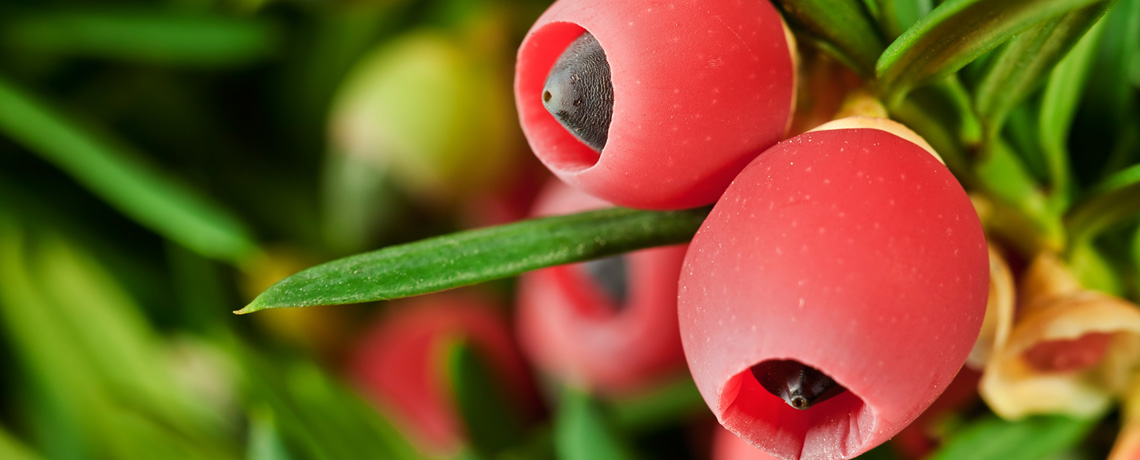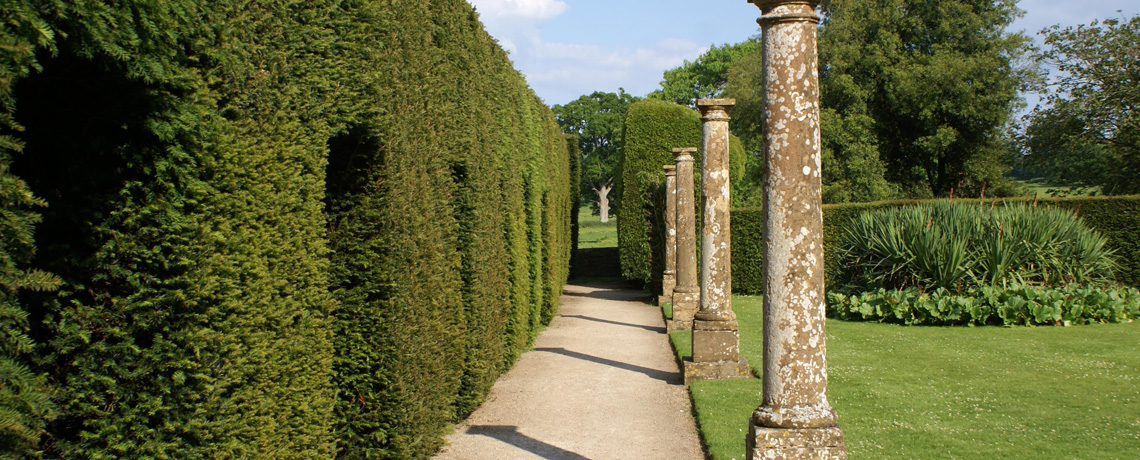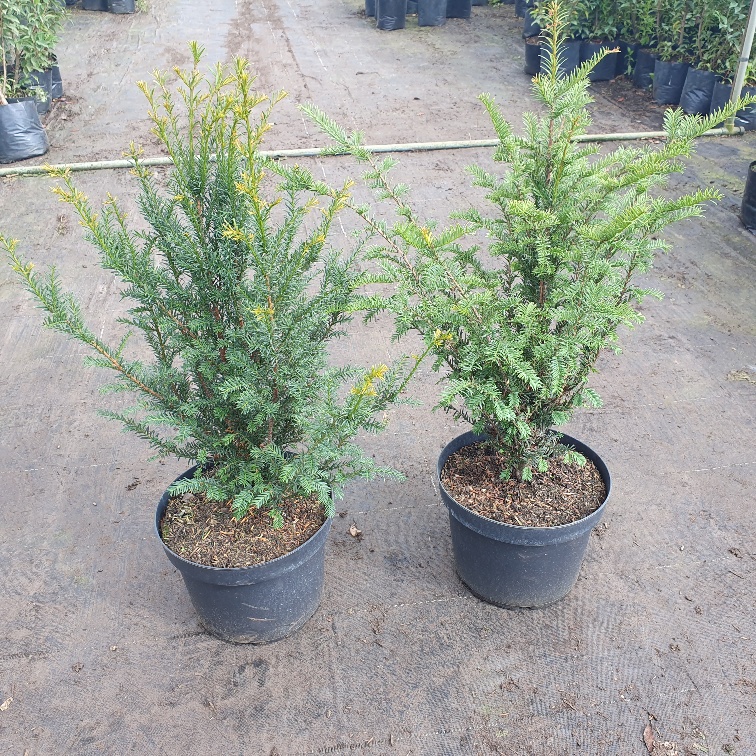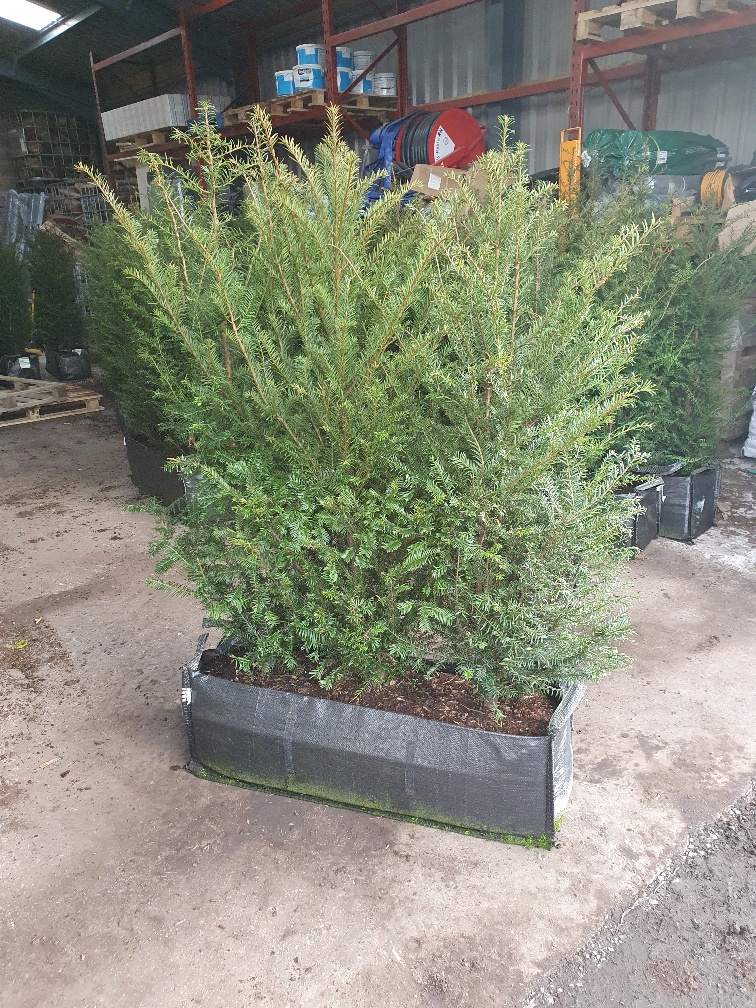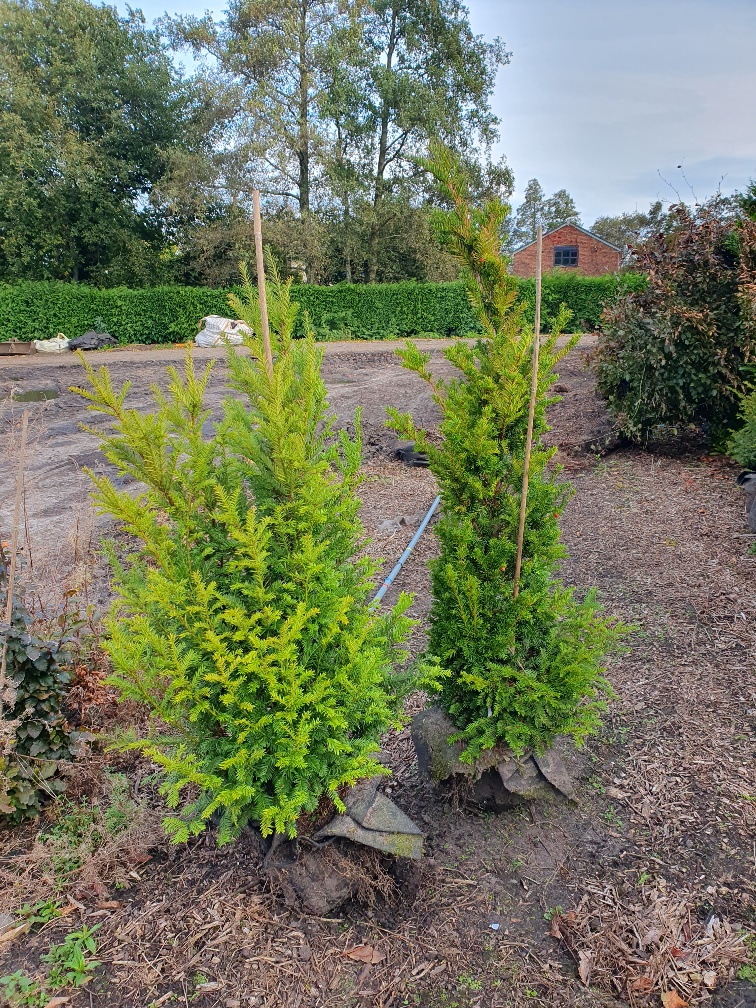About our Yew / Taxus Baccata hedging plants.
Yew hedging plants, also known as Taxus baccata are classic hedging plants and have been used for centuries as defining features in the gardens of many English country homes. Yew hedges have stood the test of time and are still a very popular choice for a new hedge. Yew hedges are often considered slow growing, but often grow more quickly than anticipated. At 30cm on average per year, a six-foot hedge can be achieved in an acceptable timeframe. There are advantages to being slower growing! Once your Yew Hedge has reached the desired height and shape it will be much easier to maintain. Yew hedges can be easily clipped with hedge trimmers and are very tolerant of close clipping making them very suitable for topiary. Yew hedges have small, linear, dark green leaves. The male plants produce yellow cones in spring, which give rise to the small, red, seed-bearing fruits on female plants. A Yew hedge will make an excellent feature within any contemporary or traditional setting.
Why Plant a Yew / Taxus Baccata Hedge?
Yew has often been labelled as ‘The King of Hedges’. This must have something to do with the widespread popularity of yew hedges in the many fabulous gardens of Palaces, Country Houses and Stately Homes. This long lived conifer tree makes the most magnificent hedge that will continue to look impressive for decades. Due to its slow growing nature, Yew lends itself beautifully to creating Topiary and elaborately shaped hedges. The small leaves trim very well with hedge trimmers and the slow growing nature make the maintenance of Yew hedges much less of a chore. Yew hedges are tough, resilient and hardy plants and will tolerate most conditions and soil types except waterlogged sites.
Are Yew / Taxus Baccata Evergreen Hedging Plants?
Yew/ Taxus Baccata are fully evergreen conifer trees.
How fast does Yew / Taxus Baccata Hedging grow?
The growth rate for a newly planted Yew Hedge is around 20-30cm per year on average but sometimes quicker. The speed of growth will also vary depending on things such as how well the ground is prepared prior to planting. Has the planting site has been sufficiently decompacted. Are the Yew plants, planted correctly. After planting, are the Yew plants fed and watered regularly. Potted plants will generally establish quicker than rootballed or bare root Yew tress as there is no disturbance to the root system.
How Tall will Yew / Taxus Baccata Hedging Grow?
Yew trees can grow up to 12 metres or more when fully grown so a Yew hedge can be as high as you like really. Yew trees can comfortably be maintained as a hedge anywhere from 1 metre high upwards.
How many Yew / Taxus Baccata Hedge plants per metre?
The spacing of plants in a Yew hedge really is dependent on the size of plants that are being planted as well as the time you are prepared to wait for the hedge to grow and also budget constraints. If using our 10 litre potted Yew hedging plants, then we would recommend planting at 2.5 or 3 plants per metre. We use 3 plants per metre for our Instant Yew hedge grown in 90 litre troughs. This way the plants are just about touching when planted, so giving them space to grow into, but not too much that you are left with big gaps in the hedge. We give a recommendation of the planting density for each plant size on the website. Our recommendations are based on planting at a density that the hedging plants will touch after 1 full growing season. This is only a guideline and please use more plants to reduce this timescale or less plants per metre if you have time to wait.
How do I plant Yew / Taxus Baccata hedging?
Most of the Hedging plants that we sell will require the same planting procedures. We give advice on how to plant a Yew hedge here on our website. https://hedginguk.com/hedging-advice/how-to-plant-a-hedge/
When to plant a Yew / Taxus Baccata hedge?
Our favoured time for planting any hedge is in the Autumn. Our main reason for this is that it requires less work. The plants have started to slow down for the Winter. With little top growth at this time of year, the plants are requiring less water. Normally as we come into Autumn the weather has begun to change and brings with it, a fair amount of rain. The volume of rain is normally sufficient for us to turn the watering off almost completely on the nursery until Spring. The soil temperature is usually still warm enough for the plants to start making new roots after planting. With any luck, any Autumn planted hedging has a good chance of having enough roots established to be off the mark quickly come Spring with very little work.
Of course, if you are buying and planting bare rooted or rootballed Yew hedges then this is really only available from Autumn through to Spring anyway. If you are planting potted yew hedges then the planting season is extended and planting can take place outside of this timeframe. Obviously, any Summer planted hedges will require more effort (watering) to ensure success.
When to trim a Yew / Taxus Baccata hedge?
We trim our Yew hedges 2 times a year on the nursery. We generally do this Late Winter/ Early Spring, then once in the Summer. Sometimes, if necessary or we miss the Summer trim we do them again in the Autumn. However when planted in the garden as a hedge Yew can be trimmed once a year. Yew hedges will tolerate hard pruning if the hedge has grown wider or taller than desired. Trimming your Yew hedge more frequently will require less work each time and less trimmings to dispose of.
Can you hard prune a Yew / Taxus Baccata hedge?
A Yew hedge is very tolerant of hard pruning. If your hedge has grown too wide or taller than desired then there is a very good chance it can be restored with a hard prune. Hard pruning is best carried out in late Winter before the new growth starts to come through. If undertaking a very hard prune, (back to the main stems) then we would recommend to just do one side of the hedge in one season and the other side of the hedge the following season. This will limit the amount of stress imposed on the plants at any one time whilst also leaving some cover on the remaining side retaining some privacy and protection whilst the hard pruned side recovers.
How to trim or cut a Yew / Taxus Baccata hedge?
A Yew hedge is easily cut or trimmed using hedge trimmers. Very closely clipped Yew hedges and hedges with elaborate designs and shapes are often closely clipped with handheld hedge shears.
Feeding a Yew / Taxus Baccata hedge?
We would recommend at least one annual feed for your Yew hedge. Slow releasing feeds are generally considered best as they provide a steady release of nutrients over a longer period of time. The best time to feed a Yew hedge is in the Spring just as the new leaves come through. On the nursery we would follow this up with a late Spring feed and also at least one feed in the summer.
What type of soil and conditions will a Yew / Taxus Baccata hedge grow in?
A yew hedge prefers a moist but well drained soil and a sunny or partially shaded position. However, Yew hedges are very versatile and will grow in most reasonably fertile soils and will even tolerate chalk soils. They will not grow in very wet sites or waterlogged soils. Yew hedges will grow in full sun or partial shade, although they will grow quicker the more sun they receive.
Are Yew / Taxus Baccata hedges easy to maintain?
Being a slower grower of all the hedging plants we grow and sell. Yew hedges will be one of the easiest hedges to maintain with just an annual trim. However as they lend themselves so well to being shaped as topiary hedges, many creative gardeners use Yew to create some fantastic and sometimes unusual hedges. These more creative creations will always look their best with regular trimming throughout the growing season.
Do you grow Instant Yew / Taxus Baccata Hedges?
We do grow Instant Yew hedges here on the nursery in 90 Litre troughs. Our Yew instant hedges have 3 plants per every metre of hedge. The root systems of the 3 plants are all knitted together to form a continuous 1 metre strip of hedge. The top part of the hedge will have been trimmed numerous times to create more density and to encourage the plants to knit together as a hedge.
What Yew / Taxus Baccata hedging plants do you have for sale?
We grow a range of sizes of Yew hedging plants for sale here on the nursery. We grow potted Yew hedging plants, mainly in 10 litre pots. For more immediate impact, we also grow our Instant Yew Hedges in 90 Litre troughs. The instant hedges come in 1 metre lengths but do require 2 strong people to lift them.
Do you grow your own Yew / Taxus Baccata hedging Plants?
All the Yew hedging plants that we sell are grown outside here on our nursery in Holmeswood, Lancashire producing robust plants that are quick to establish.
Are Yew / Taxus Baccata Hedging plants poisonous?
The short answer is yes. All parts of Yew hedging, including leaves and berries are toxic to Humans, Livestock and animals if injested. If the hedge to be planted is in the vicinity of livestock, pets or very small children where there is a chance that the foliage or berries of the hedge could be eaten by mistake, then we would suggest planting an alternative species of hedging such as Elaeagnus Ebbingei, Griselinia Littoralis or Photinia Red robin which have no toxic effects reported. We grow and sell thousands of Yew Trees every year and are not aware of any problems arising from any of our customers after planting a Yew hedge in close proximity of either pets or young children. We would however suggest that after pruning your Yew hedge that all the material that is cut from the hedge be collected up and disposed of in green waste bins rather than composting at home.

